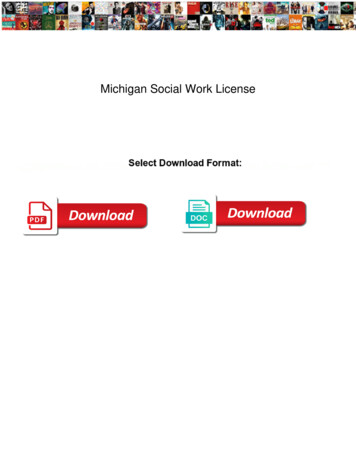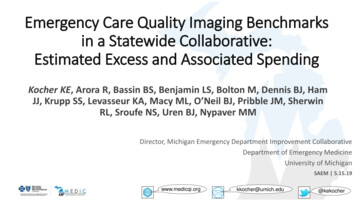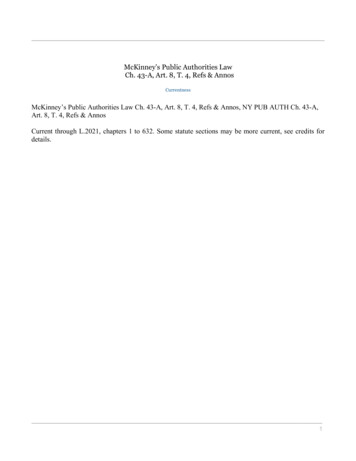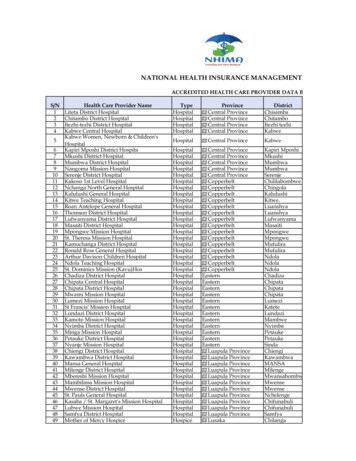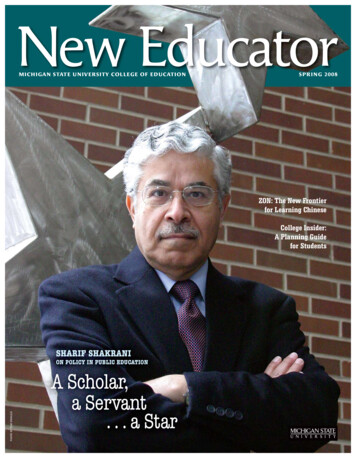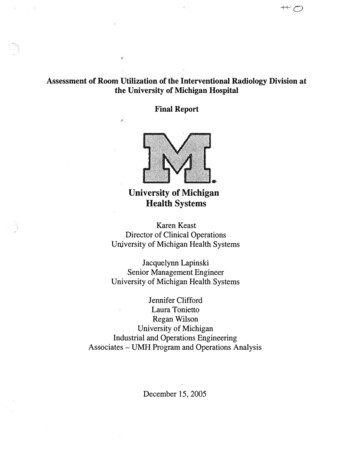
Transcription
Assessment of Room Utilization of the Interventional Radiology Division atthe University of Michigan HospitalFinal ReportUniversity of MichiganHealth SystemsKaren KeastDirector of Clinical OperationsUniversity of Michigan Health SystemsJacquelynn LapinskiSenior Management EngineerUniversity of Michigan Health SystemsJennifer CliffordLaura ToniettoRegan WilsonUniversity of MichiganIndustrial and Operations EngineeringAssociates UM}{ Program and Operations Analysis—December 15, 2005
Table of ContentsList of Tables and FiguresExecutive SummaryMethods of data collection and analysisKey Findings and RecommendationsIR Division has 14% opportunity to increase utilizationRoom 6 utilization is at 48%Time StudiesIntroductionBackgroundKey IssuesProject Goals and ObjectivesProject ScopeApproach and MethodologyCollected DataObservations and interviewsUtilization measuresTime studiesHistorical dataLiteratureAnalysis of FindingsDeveloped Recommendations and an Action PlanResultsPerceptions from InterviewsFlow ChartsHistorical DataJR Division Room UtilizationIndividual IR Room UtilizationJR Utilization per HourRecommendations from Utilization per Hour and Utilizationper Room per ShiftImplementing RecommendationsAnesthesiologist Case FindingsFellowsFindings from Technologists FilmingJR Time Study ResultsFuture Analysis16161717181827Works CitedAppendix A. Utilization Measures Data Collection SheetAppendix B. Time Studies Data Collection SheetAppendix C. Utilization Measures: Hours 1
List of Tables and FiguresExecutive SummaryTable 1. Summary of utilization percentagesTable 2. Key findings from time studies44Main ReportTable 1. Hours Staffed in the Interventional Radiology Division per Room6Figure 1. Room Turnover in the JR divisionFigure 2. Patient FlowFigure 3.Visceral Statistics for Patient Volumes of JR DivisionFigure 4. Room State PercentagesFigure 5. Utilization per RoomFigure 6. Utilization of the JR Division per Hour Highlighting Turnover TimesFigure 7. JR Room Utilization Per Room per ShiftFigure 8. Percentage of Anesthesia CasesFigure 9. Time Study 1Figure 10. Time Study 2Figure 11. Time Study 3Figure 12. Time Study 4Figure 13. Time Study 5Figure 14. Time Study 6Figure 15. Time Study 7Figure 16. Time Study 8Figure 17. Time Study 9Figure 18. Time from when set-up is complete until new patient enters roomFigure 19. Time between patient arrival and doctor arrival101111121314151719192021212223232425252
Executive SummaryThe Interventional Radiology (ER) division at the University of Michigan Health Systemsbelieves that there is opportunity to increase utilization of rooms in the division to betteraccommodate all patients who need a radiology procedure performed. The team had been askedby the Director of Radiology Clinical Operations, Karen Keast, to observe room turnover andquantify room utilization.Methods of data collection and analysisTo quantify room utilization, the team collected 219 data points during a time with patientvolumes at a normal level. The data included the state of each room in the IR division, whetherthe case was for an inpatient or an outpatient, whether an anesthesiologist was needed, whether afellow was present, and whether the technologist was filming at the time. The team developed atime collection schedule to maximize the coverage from 7:00 am 8:00 pm, Monday throughFriday, which are the division’s hours of operation. Data points were collected every 15 minutesduring this time period. After the utilization measures were collected, the team performed timestudies of 9 room turnovers. The team analyzed the data and developed recommendations toincrease room utilization based on their analysis. The team then used modeling to find theexpected impact of their recommendations on the JR division and developed an action plan toimplement their recommendations.—Key Findings and RecommendationsBy analyzing utilization in rooms 1,2,3,5 and 6, the team was able to define utilizationthroughout the division. Based on the 219 data points of utilization measures collected betweenOctober 11 and November 21, 2005, the team calculated the utilization of the ER division as66%.JR Division has 14% opportJniiy to increase utilizationIn the article “OR Efficiency,” OR Manager defines utilization as “the percentage of availableOR time that is used for surgical cases.” Available time refers to time the rooms are staffed andavailable to schedule cases during rime time hours, in this study, IR rooms 1, 2, 3, 5, 6, MondayFriday 7:00 am through 8:00 pm. The analysis of the utilization measurement study was basedon a target utilization of 80%.—Room 6 utilization is at 48%Analyzing utilization percentages per room revealed that room 6 was utilized only 48% of thetime observed, while the other 4 rooms were operating at or above 65% utilization. The teamhas discovered that this is true for 2 reasons. Room 6 is the smallest room and offers the lowesttechnology compared to the other rooms, limiting the number of procedures that can beperformed in this room. Also, room 6 is blocked off for Neuro-IR procedures until 1:00 pm.With this consideration, the team recalculated utilization in room 6 from 1:00 pm- 8:00 pm, andfound that the utilization decreased to 33%.Based on these findings, the team recommends the following:1. Schedule simple procedures in room 6 first3
Which will: Increase utilization of room 6 to 56% based on modeling2. Reduce time allotted to Neuro-IR Increase capacity in room 6Analysis of utilization percentages per hour revealed a high level of inconsistency throughout theday. The team is aware that after 6:00 pm, the staff is reduced to only support rooms 1 and 2,and therefore also defined utilization to only include rooms 1 and 2 during these times. Table 1lists the key findings from analyzing utilization data at different points in the day.Table 1. Summary of utilization percentagesUtilization from 7:00-8:00 amUtilization in the morning (7:00 am 11:15am)Utilization in the afternoon (11:15 am 3:30pm)Utilization in the evening (3:30 pm 8:00 pm)--———0%62%80%53%Based on these findings, the team recommends the following:1. Begin first procedure in each room at 7:00 amWhich will: Increase number of patient cases per day by 6 based on modeling Increase utilization percentage to 100% at 7am based on modeling2. Operate at constant 80% utilization throughout dayWhich will: Level workloads (Heijunka) Optimize worker utilization in IR, allowing for emergent cases in scheduleTime StudiesThe team conducted 9 time studies on the room turnover process in the IR division. Time studiesrevealed a high level of variability in both job sequence and turnover time. The key findingsfrom time studies are listed below in Table 1.Table 2. Key findings from time studiesAverage room turnover timeRange of room turnover timesAverage room set up timeRange of room setup timesAverage room set up time with pre-set up :15:58Based on these findings, the team recommends the following:1. Standardize room turnover in JR divisionWhich will: Eliminate job function confusion Eliminate tasks being overlookedo Obtaining consent4
o Calling anesthesiologyo Hand-off of job functions when staff or faculty are absent Create most efficient and effective process Create “Standardized Work Instructions” for each job functiono Operate at maximum worker efficiencyo Clear job responsibility Eliminate non-vahie added taskso Waiting, excessive walking, multiple handling reduced Reduce turnover timeo Increase capacity in IR divisiono Increase utilization in JR division2. Set up trays in advance of procedure‘Which will: Reduce turnover time by approximately 15 minutes Perform turnover faster by eliminating task Create a buffer for more efficient patient throughput3. Introduce visual cues and pull system between JR room and prep/recovery (kanban)‘Which will: Reduce time rooms are emptyo If reduce by 80%, utilization would increase to 75% based on modeling Reduce time between set-up completion and patient entering roomo Kanban would pull patient to eliminate time between processes Improve information flow Reduce human error Aid in managing board and patient scheduling Reduce time between processesAlthough the team has recommended opportunities to increase utilization in the JR division,further analysis is needed to determine whether other factors outside of this project’s scope areaffecting the overall utilization percentage in the IR division. For example: ‘What is room turnover “best practice?” Reduce time between casesWalk pathsJob sequenceCan consent be obtained more efficiently? Reduce time between casesCan inpatient transport be more efficient? Reduce people involved in process Reduce time between casesCan patient scheduling be more efficient? Increase throughput of patientsCan task be moved from the JR division to prep/recovery? Reduce average times for procedure and room turnover-- a 5
IntroductionCurrently the Interventional Radiology (IR) division of The University of Michigan HealthSystems (UMHS) believes there is opportunity to increase room utilization. Therefore, theDirector of Radiology Clinical Operations asked the team to observe room turnover and quantifyroom utilization. After the team observed the division and collected data, the team analyzed theinformation and developed recommendations to better accommodate patient flow and optimizethe usage of the current JR rooms. The purpose of this paper is to present findings from theproject, make recommendations, and propose an action plan to implement the recommendationsin the IR Division.BackgroundThe JR division performs over 85 different procedures. These procedures are performed onboth inpatients and outpatients, which are scheduled differently. Usually outpatient cases arescheduled in advance, while inpatient cases are fit in between scheduled appointments. Before acase may begin, the following must occur: Consent must be obtained Lab values must be approved Patient must be present One doctor, nurse, technologist, and sometimes an anesthesiologist must be present Room must be readyIn addition, the JR division is on call for emergency procedures 24 hours a day, 7 days a week.These emergent procedures always pre-empt scheduled cases.Although the JR division’s hours of operation are 7:00 am to 8:00 pm, Monday through Friday,the division is not fully staffed for their entire hours of operation. The division considers thetimes shown in table 3 below to be the hours staffed in the JR per room.Table 1. Hours Staffed in the Interventional Radiology Division per RoomRoom 17:00 am 8:00 pmMonday FridayRoom 27:00 am 8:00 pmMonday FridayRoom 37:00 am 6:00 pmMonday, Tuesday,Wednesday, Friday7:00 am 8:00 pmThursdayRoom 57:00 am 6:00 pmMonday FridayRoom 67:00 am 4:00 pmMonday Friday7:00 am 1:00 pmBlocked off for Neuro-IR———————--—Key IssuesThe following key issues were considered as potential opportunities to increase efficiency in JRroom utilization: Scheduling of necessary staff Obtaining necessary lab values6
Communication in preparing an inpatient for a procedureCompletion of consent formsLimitations in room functionalityVariability in room turnoverGoals and ObjectivesIn order to observe room turnover and quantify room utilization, the team has performed thefollowing tasks: Conducted utilization sampling of JR rooms Collected 219 utilization data points of variables possibly affecting procedure timing Analyzed utilization data points to quantify utilization in the IR division Conducted 9 time studies on the cycle of room turnover Interviewed 8 key personnel in the division to define process flow Analyzed the last 2 fiscal years of department volumes to validate sampling method andsample period Performed literature search to confirm definition of room utilization and set a target goalfor room utilization based on similar departmentsWith this information, the team has developed the following: Recommendations to increase efficiency regarding room preparation and usage An action plan to implement the recommendations in the divisionProject ScopeThe project includes analysis of: Cases in rooms 1,2,3,5, and 6 Cases during JR hours of operation (7:00 am to 8:00 pm, Monday through Friday)The project excluded analysis of: Cases in Neuro-IR room 4 Procedures, preparation and recovery time for patients that occurs outside of the JRdivision Cases that are performed outside of normal operating hours Cases outside of the JR division Cases during the week of October 17The team did not collect data during the week of October 17 because several of the facultymembers were on vacation, making the data unrepresentative of the population.Approach and MethodologyThe team completed the project in three steps:1. Collected data: Observations and interviews7
Utilization measures Time studies Historical data Literature2. Analyzed findings3. Developed recommendations and an action planData CollectionObservations and InterviewsThe team began data collection by interviewing eight key personnel to learn job functionality andprocesses in the division. The team then observed the division to better understand thevariability and environment, to validate the process flow, and to solidify their methods of datacollection.Utilization MeasuresThe team created a schedule for collecting utilization measures to ensure the sample would rangefrom Monday through Friday, 7:00 am to 8:00 pm. The team collected 219 utilizationmeasurements between October 11 and November 23, 2005. A copy of the data collection sheetthe team developed and used as well as a brief description of the collected items is in AppendixA.Time StudiesBetween November 8 and November 23, the team performed time studies of 12 room turnovers.The team first performed 3 time studies together to solidify their collection methods. Once theteam felt the collection method was synchronized among members, the team collected 9 timestudies to be used in data analysis. These time studies were collected to support and confirm theutilization measurements the team had already collected. The time study data collection sheet, aswell as the definitions of collection points is located in Appendix A.Historical DataThe team obtained patient volume statistics from the JR division for the Fiscal Years 2004, 2005and the beginning of the fiscal year 2006. This information was used to confirm that data wascollected at a time representative of past patient volumes.Literature SearchThe team used the article “OR Efficiency: Is an 80% to 85% utilization a realistic target forORs?” from OR Manager in May, 1997 to define a target utilization percentage for the IRdivision.Analysis of FindingsThe team began data analysis during the data collection phase in order to test analysis methods.The team began to make interim conclusions based on the collected data, continually analyzingthe data through the end of the data collection phase. After remaining data was collected, theteam completed analysis.8
Development of RecommendationsBased on the team’s findings, both quantitative and observational, the team formulatedconclusions and recommendations. The team then used both logic and modeling to predict theexpected impact of each recommendation on the JR division. The team tested therecommendations with the client and coordinator in order to understand implications andpossible resistance.ResultsThe following section contains the results and findings of the project analysis. Each finding ispresented with a corresponding recommendation, action plan, and expected impact section, ifapplicable.Perceptions from InterviewsThe team is aware that information acquired through JR staff interviews is perception, and maynot be factual. Collected data was used to confirm or refute those perceptions.During staff interviews, process flows for both patient throughput and room turnover weredeveloped. These process flows were then validated by the team by observations.The team interviewed eight members of the JR division’s staff, including a physician assistant, anurse practitioner, a radiology outpatient assistant, two JR radiology assistants, twotechnologists, and the nurse supervisor. Of the staff that was interviewed, all but one believesthat there is a possibility to increase JR room utilization. The remaining staff members estimatedutilization was between 70 and 85%. Although the staff believes that the rooms are not atmaximum utilization, they believe that the staff is being utilized maximally, and often feel theneed to be in several places, doing more than one task at a time. The staff perceived four mainareas that were believed to be limiting JR utilization. Obtaining consent is difficult and sometimes slows the process. Recognition ofpatients that cannot consent for themselves needs to occur prior to patient arrival inpreparationlholding. Room turnover slows the process. Rooms need to be turned over more efficiently andfaster. This delay may occur because not all of the necessary staff is present to aid inthe turnover process, or could occur as a result of changes in the next scheduledprocedure demanãing different tools. The pre-procedure process could be improved. Information is relayed betweenseveral staff members and locations, delaying the process. Obtaining patients’consent and lab values also proves to be difficult due to disconnects in theinformation process. Limitations arise due to the inflexible nature of certain rooms, such as inadequatespace for needed staff members and inadequate equipment. Room 6 is limited byboth technology nd space, and is unable to support more complicated procedures andcases requiring anesthesia.9
The staff believes that rooms 1 and 2 have the highest utilization, as they are the largest andsome doctors prefer to be scheduled in those rooms first. After rooms 1 and 2, room 3 isperceived to be utilized the third most efficiently, followed by 5 and 6, respectively. The staffbelieves that Mondays and Fridays experience the most demand and the JR division is the busieston those days. Also, most feel that the morning hours are the busiest time of the day. Thedemand that the staff has ben encountering since data collection began is believed by the staffmembers to be a representative sample of the demand felt throughout the year.Flow ChartsThe team developed flow charts from both observing the department and interviewing staffmembers of the JR division. The charts depict tasks for each job function during both roomturnover and patient flow in the department, and identify delays in those processes with the “D”shapes. (Figure 1)()Pemon(s)WhOdoctorJ”r\-,nurseJ1Nurse removespabent from mom‘1]D -HTray tear-downandnvalofsoiled Itemsset up roomoepatJCornpe IndngtechnologistFigure]. Room Turnover in the JR divisionFigure 1 above depicts the process of room turnover in the JR division, from when the procedureis completed until the room is ready for the next patient to arrive. Delays in the process arebetween when the case is completed and the patient leaves the room, and when the trays arebeing torn down and the room is being set up for the next patient. This process is not followedfor every room turnover. There is a high level of variability and tasks are not always performedin the same order. The teamfurther analyzed this during time studies.Figure 2 below depicts the process of obtaining a patient and bringing that patient to an availableroom.10
Call floorinpatientcontrolleroutpatientWaft./fN, JObtainconsent[arnurseFigure 2. Patient FlowAs identified in Figure 2, there is a delay when the division is waiting for an inpatient to bebrought to the preparation area. After the patient is in the preparation area, obtaining consentsometimes delays the process of bringing the patient to the IR room. The team used time studiesto further analyze delays in patient flow that are in the scope of this project.Historical DataThe team analyzed the historical data in order to determine normality of the period of time inwhich data was collected for the project. The following graph summarizes the information theteam received.600500FY 20O.- -.-- ------/.FY 2004O0VFY2004\‘——.--.-.-— ——,/300I.0E2001000--—Figure 3. Visceral Statistics for Patient Volumes of JR Division11
Figure 3 shows that the month in which the team collected data experienced volumes similar tothat of fiscal year 2005, and slightly higher than those of 2004. The team also verified that thecollection of the utilization measures covered the full scope of days and hours of operationidentified in the scope. Certain hours of the week were unable to be represented due to otheracademic obligations of the team, however hours sampled are sufficient to gain an accuratepicture of the overall utilization. A chart of the total time covered can be found in the appendix.(Appendix C. Utilization Measures: Hours Collected) The team can therefore use all subsequentfindings to produce recommendations for the division.JR Division Room UtilizationIn the article “OR Efficiency,” OR Manager defines utilization as “the percentage of availableOR time that is used for surgical cases.” (Patterson, Works Cited) Based on OR Manager’sdefinition of utilization, the team defines utilization as the sum of the pre-procedure, procedure,and turnover times in JR rooms 1, 2, 3, 5, 6, Monday Friday 7:00 am through 8:00 pm.—The analysis of the utilization measurement study was based on a target utilization of 80%. Thiswas decided based on the article from OR Manager. “Experts agree that 80% to 85% is themaximum utilization an OR can be expected to reach.” (Patterson, Works Cited)Based on the data collected between October 11 and November 23, 2005, and covering the hoursof 7am-8pm Monday-Friday for rooms 1, 2, 3, 5, and 6, the team calculated the total percentageof each room state. See figure 4 below.TurnoverI I 0/I I /037%Pre-procedure18%Figure 4. Room State PercentagesInterventional Radiology division utilization is currently 66%. This calculation of utilizationis based on the division’s hours, and is therefore from a customer perspective. Based on thetarget utilization of 80%, the Interventional Radiology division therefore has 14% opportunity to12
increase utilization. The successive findings from the study and recommendations canpotentially increase the room utilization to be closer to this goal.When considering utilization from a staffing perspective, the division is at 71% utilization. Thisis based on the staffing schedule that is shown in Table 3. Since this project is definingutilization of the JR division, successive calculations will be based on utilization from a customerperspective, spanning 7:00 am 8:00 pm for rooms 1,2,3,5, and 6, unless otherwise noted.—Individual JR Room UtilizationWhen analyzing the data, thg team also considered utilization of each individual room. Eachroom is slightly different, both in square footage and equipment available. A representation ofindividual room utilization based on the utilization measures is shown in Figure 5.100%90%80%70%60%50%40%30%20%1 eo/I ‘J /0(0/‘.J /0Room 1Room 2Room 3Room 5Room 6Figure 5. Utilization per RoomFigure 5 shows that room 6 has the lowest utilization at 48%, while the other 4 rooms areoperating at or above 65% utilization. The utilization of room 6 is the lowest for two reasons.First, room 6 is the smallest room and is the least equipped when compared to the other rooms,which limits the number of interventional procedures that can be performed in room 6. Also,room 6 is scheduled for Neuro-IR procedures until 1:00 pm. With this consideration, theutilization was recalculated for room 6 from 1:00 pm- 8:00 pm. This reduced the utilizationslightly to 45%, suggesting that room 6 has the potential for utilization to be increased by 35%.Based on these conclusions, the team recommends that smaller and simpler procedures such asP1CC lines be scheduled to room 6 before larger rooms. Implementing this recommendationwould increase the number of cases that room 6 holds, and would free the larger rooms toaccommodate more complicated procedures and better utilize their equipment.To predict an expected impact of this recommendation, the team modeled new data in which aprocedure would be performed in room 6 for every block of time the room was empty for over13
1.5 hours. Based on the length procedures and turnovers observed by the team, 1.5 hours wouldbe enough to accommodate a short procedure and allow for enough time to set up for the nextcase. For this model, the team considered the hours of operation for the division. Based on thismodel, this recommendation could increase the utilization of room 6 to 74%, which is consistentwith other rooms in the division. This increase in room 6 utilization would translate intoperforming 1 additional procedure to room 6 per week. It would also bring total utilization in theJR division to 71%.The team also recommends a smaller time be blocked off for room 6 to be used for Neuro-IR.From 7:00 am— 1:00pm, Neuro-IR is utilizing the room 53% of the time. If room 6 wasavailable to the rest of the JR division before 1:00 PM, the overall utilization could be increased.To increase utilization in room 6, the team suggests increasing communication with Neuro-IR.The utilization of both time blocks from 7:00 am 1:00 pm and 1:00 pm 8:00 pm are 27% and35% below the target utilization, respectively. By increasing communication between the twogroups, a better schedule may arise in order to better accommodate both groups.——JR Utilization per HourThe team then analyzed the utilization of the IR division per 20%10%0%7:00 8:00 9:00 10:00 11:00 12:00 1:00 2:00 3:00 4:00 5:00 6:00 7:00AM AM AM AM AM PM PM PM PM PM PM PM PMTimePreprocedure and procedure time TurnoverjFigure 6. Utilization of the JR Division per hour highlighting turnover times14
Figure 6 shows the utilization per hour in the ER division from 7:00 am 8:00 pm. Thisutilization is divided into pre-procedure procedure times and turnover time.—There is a high level of variability in utilization throughout the day. All rooms are empty from7:00 am to 8:00 am. At 8:00 am, the division increases to 52% utilization. After 8:00 am, the IRdivision is utilized at about 80% from 9:00 am to 4:00 pm. Between these times, the division isutilized above 80% for 4 hours. At 4:00 PM, the division’s utilization slowly decreasesthroughout the evening.Due to the inconsistent level of utilization, the team further analyzed the utilization in the ERdivision by dividing the hours of operation into three blocks. These blocks represent “morning”,“afternoon”, and “evening”. Block 1 runs from 7:00 am to 11:30 am, block 2 runs from 11:30am-3:30 pm, and block 3 runs from 3:30 pm to 8:00 pm.IR Room Utilization Per Room Per Shift100%90%80cYoca)Oa) -70/añ0/‘J’., i050%40%I:D10%0/‘) /021356IR Room NumberFigure 7. JR Room Utilization Per Room per ShiftFigure 7 shows that all of the rooms are near the 80% utilization target for the afternoon withroom 5 being the most utilized during this time block. The afternoon time block (11:30 3:30pm) has a higher utilization percentage than both the morning and evening blocks for all IRrooms. Figure 7 also validates that room 6 is the least utilized in both the morning and eveningblocks has the greatest variability in utilization throughout the day. Room 2 has the mostconsistent utilization throughout the day.—Conclusions from utilization per hour and utilization per room per shiftCurrently, the division is running at an inconsistent level of utilization. Rooms are not beingutilized efficiently from 7:00 am 8:00 am, and resources are being strained when the divisionoperates above 80% utilization in the late morning and early afternoon. The article in OR—15
Manager states that “over [the target percentage] the department loses flexibility and needs toconsider added capacity”. Since the division overall is not above the target utilization, addedcapacity is not necessary. Instead, the division must work to operate at a consistent 80%utilization.Turnover accounts for 11% of total time in the division, which is high. If room turnover timecould be decreased, the division would have opportunity to perform more cases per day andincrease the amount of time ivailable for cases in each room. This could increase the throughputof the division, and reduce the wait time for both inpatients and outpatients.When room turnover is separated from pre-procedure and procedure time, it becomes obviousthat there is a large dip in utilization during lunch hours. Turnover may take longer during thesetimes when staff members relieve each other to allow for lunch breaks. For example, if atechnologist has been present for a procedure and is relieved for lunch by another technologist atthe end of the procedure, it would take longer for the relief technologist to finish filming andpaperwork than it would for the technologist that was present for the procedure. The time itwould take for the relief staff member to learn the case could increase the time needed forturnover.With an inconsistent amount of time spent for room turnover throughout the day, analysisregarding room turnover processes becomes even more important.Recommendations from Utilization per Hour and Utilization per Room per ShiftBased on the findings from utilization per hour and utilization per shift per room, the teamdeveloped two recommendations.1. Begin the first procedure in each room at 7:00 am, beginning the day at 100% utilization.2. Operate at a constant 80% utilization throughout the day.By beginning each procedure at 7:00 am, the division will be able to increase the utilization inthe first hour of the division to 100% utilization. After the initial procedures hav
fellow was present, and whether the technologist was filming at the time. The team developed a . By analyzing utilization in rooms 1,2,3,5 and 6, the team was able to define utilization throughout the division. Based on the 219 data points of utilization measures collected between . OR time that is used for surgical cases." Available time .





